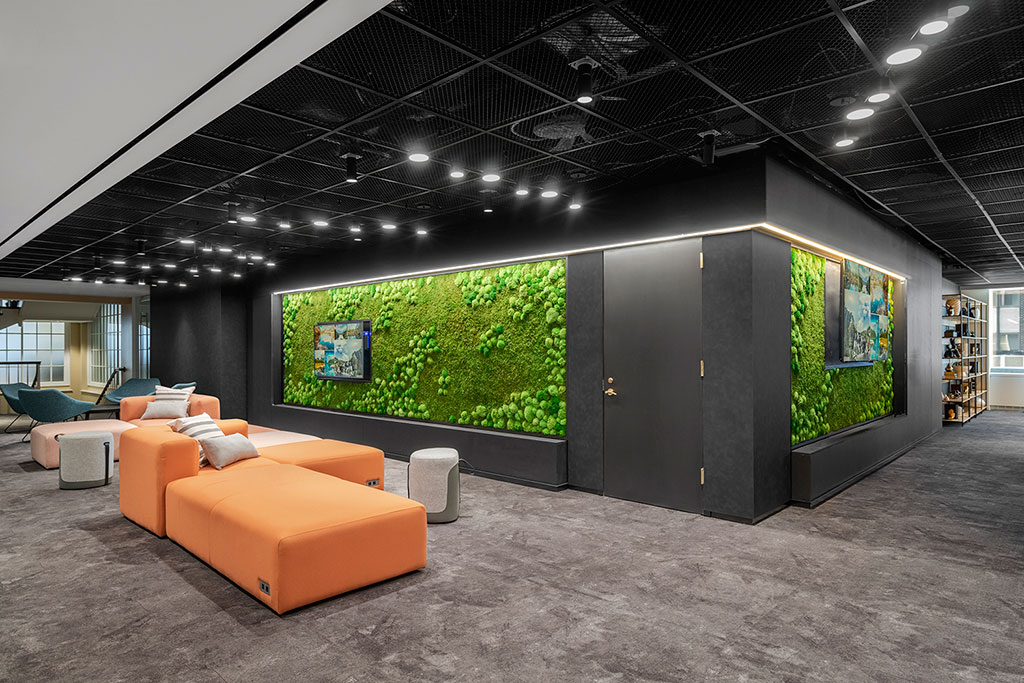Understanding Biophilic Design
Biophilic design aims to bring nature into modern spaces to improve well-being. It integrates natural elements like preserved moss to create a connection to the outdoors. Benefits of biophilic design include reducing stress, enhancing creativity, and improving air quality. Key principles involve incorporating natural light, living or preserved plants, and natural materials. Research indicates that biophilic design can boost produc
What is Preserved Moss?
Preserved moss is natural moss that has been treated to maintain its look and feel without needing regular watering or sunlight. This moss is commonly used in interior design to bring a touch of nature indoors, creating a calming and biophilic atmosphere. Preserved moss comes in generally green tones and with some different textures, making it a versatile option for adding a bit of greenery to modern spaces without the need for maintenance.
Benefits of Biophilic Design in Modern Spaces
Biophilic design brings nature indoors, creating a calming and refreshing environment. Studies show that it can reduce stress, improve mood, and increase productivity. By introducing preserved moss into modern spaces, you can experience benefits like improved visual interest, enhanced creativity, and a sense of well-being. Preserved moss requires little maintenance, making it a sustainable and cost-effective way to incorporate biophilic elements into your living, working or healing spaces.
The Role of Preserved Moss in Biophilic Design
Preserved moss plays a crucial role in biophilic design by bringing nature indoors. Moss not only adds a touch of greenery to modern spaces but also contributes to creating a calming and natural environment. It requires minimal to no maintenance, making it a sustainable and long-lasting choice for incorporating nature into interior design. Moss can be used in various ways, such as on walls, in artwork, or even in furniture, providing a unique and organic element to the overall design concept. Its ability to improve air quality and reduce stress levels makes preserved moss a popular choice for enhancing biophilic design in contemporary settings.
Incorporating Preserved Moss in Interior Decor
Preserved moss adds a touch of nature to indoor spaces and is a popular choice for modern interior design enthusiasts. It requires minimal to no maintenance and can last for years without needing to be replaced or most importantly maintained. Some ways to incorporate preserved moss in interior decor include creating moss walls, moss frames, and moss art installations. Moss walls are a trending feature that brings a sense of tranquility and beauty to any room. Moss frames are a creative way to add a splash of green to your wall decor. Moss art installations can be customized to fit the aesthetics of your space, making them a versatile option for enhancing biophilic design.
Types of Preserved Moss Available
Preserved moss comes in various types, including flat moss (grassy look), reindeer (lichen) moss, and ball moss (the spherical moss that is also called pillow of the forest). Each type offers a unique texture and appearance, allowing you to choose the one that best suits your design preference. Flat moss is flat and lush, ideal for creating a carpet-like effect, which is the grassy surface that you see in majority of the Moss Walls. Reindeer moss has a finer texture with a sponge like look and adds a delicate touch to your space. Ball moss grows vertically, and it adds a contrast to the Flat Moss with its color and spherical texture.
Maintenance of Preserved Moss in Design
Preserved moss requires minimal to no maintenance in design. It does not need watering or sunlight, making it ideal for indoor spaces. If the environment is dusty or with open windows all the time, dusting with a soft brush or a light air blow is sufficient to keep it looking fresh and vibrant. It is important to note that the preserved moss and plants can not be placed in high-humidity areas as they are prone to wilting due to loss of preservation solution. Avoid direct sunlight and exposure to heat sources to ensure its longevity and attractive appearance.
Mindfulness and Well-being Effects
Some studies suggest that being around preserved moss can promote relaxation and reduce stress levels. Incorporating preserved moss into indoor spaces can create a calming atmosphere, helping to improve well-being. This natural element also encourages people to practice mindfulness, which can lead to a sense of tranquility and improved focus.
Design Inspirations using Preserved Moss
If you’re looking to add a touch of nature to a living, hosting, healing or working space, preserved moss can be a great design element to consider. Preserved moss offers a natural and vibrant look without the need for maintenance or watering. Here are a few design inspirations using preserved moss:
- Moss Walls: Create a stunning focal point by installing a moss wall in your space. It adds texture and color while bringing a sense of the outdoors inside.
- Moss Art: Incorporate preserved moss into artwork or sculptures to bring a unique and organic feel to your decor.
- Moss Frames: Use preserved moss in frames to add a natural touch to your artwork or photographs.
- Moss Terrariums: Build mini moss terrariums to bring a bit of greenery to small spaces like desks or shelves.
These design ideas can help you enhance your space and bring the beauty of nature indoors.
Conclusion: Enhancing Spaces with Preserved Moss
If you are looking to enhance your spaces with preserved moss, it’s essential to consider the benefits it can bring to your environment. Preserved moss serves as a sustainable and low to no maintenance option for incorporating biophilic design elements into modern spaces. Its natural aesthetic can create a calming and inviting atmosphere, promoting a connection to nature within indoor settings. By strategically incorporating preserved moss into your design, you can achieve a harmonious balance between nature and contemporary spaces.
For more information on this subject and more, please visit our website: www.gardenonthewall.com


